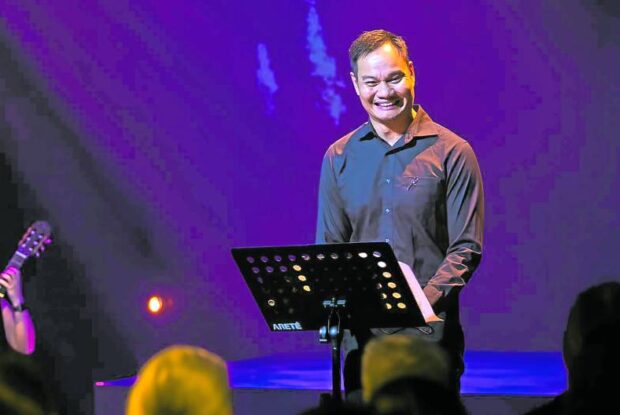Aleron, an all-male choir founded in 2006, allured its listeners in its Aug. 5 concert at the Doreen Black Box Theater at Ateneo de Manila University’s Areté in Quezon City.
Christopher Arceo, its founding director and conductor, led the 20-strong ensemble to soar gloriously to choral heights, true to the meaning of its name, “the winged one.” Aleron readily answers the country’s long-felt need for the existence of a versatile, literate male-choir in the country.
The concert, “For Light, I Close My Eyes,” is an English translation of Friedrich Ruckert’s “Taumlicht (Dream Light).” It embodies the “irony behind the persistent darkness” that confronts contemporary living, and the “hopeful aspiration as we shut our eyes to dream,” in Arceo’s program notes.
The concert is a farewell performance for Arceo, who is taking a graduate course in vocal pedagogy at the Pennsylvania State University on a full scholarship and a graduate assistantship.
Offered in two parts, the program consisted of 11 songs. Aleron did not just stand on a fixed place. Their performance was made more dynamic with the stage direction essayed by the veteran director Floy Quintos, with an appropriate lighting design crafted intelligently by D Cortezano.
Farewell performance
Many of the songs, if not all, are heard for the first time on Philippine stage. For the opening number, Aleron showcased its majesty in the rendition of Bob Chickott’s “Five Ways to Kill a Man,” cogently satirizing wars that glorify destruction of lives.
In the next number, “The Bishop and the Pagan,” a contemporary work by Veljo Tormis, three soloists, Karl San Jose (tenor), Vicente Rubio and Ryan Arcollas, both countertenors, intoned a paean for the martyrdom of Bishop Henry of Finland, a prominent leader of the crusade.
This piece found its poignant counterpoint in the succeeding song, Henrik Dahlgren’s “Son of Mother” (composed recently in 2017) that the choir rendered in full.
In Benjamin Britten’s “The Ballad of Little Musgrave and Lady Barnard,” scored for three voices, Aleron forged a rapport so tightly knitted, with the piano played by no less than concert pianist Clement Acevedo.
Excerpts from Gustav Mahler’s “Symphony No. 2, Urlicht” transcribed for choir by Clytus Gottwald in 2009, capped the first part of the program. Here, Aleron handsomely intoned the piece “Wird mir ein lichtlein geben (Give us a glimmer of light)” and brought out its crystal hymn with utmost solemnity that tugged at the heart—indeed, a most welcome balm for the tired spirit!

Aleron opened the remaining part of the program with Antonio Lotti’s ”Inganni dell’ umanita,” a sterling opener with three soloists, countertenor Ryan Arcolas, Kevin Maske tenor and Jed Marcelo (baritone) essayed the solo parts with Iqui Vinculado articulately providing collaboration on the guitar.
World premiere
In Hector Berlioz’s “Chant Guerrier,” more soloists were featured: Mico Cortez (tenor), Mark Queddeng (tenor) and Yani Pulido (baritone).
A highlight of this second part was the breathtaking performance of Jan Sandstrom’s “The Singing Apes of Kao Yai,” where the choir mimicked the sounds of a community of apes that sang in jubilation in celebration of their communal oneness and freedom. Featured soloists were tenors Kevin Mask and Ryan Arcolas and baritone Pulido, who essayed their parts convincingly!
More soloists were heard in the penultimate number, John Tavener’s “The Village Wedding,” a depiction of a Greek wedding ceremony: baritones Richard Moreno, Jerome Valdez, Lanselle Nantes, Pulido, Cortez and Jed Marcelo; countertenors Queddeng, Vivente Rubio and Ryan Arcolas. The lone tenor was Kevin Maske.
The ensemble sang tutti in the last number, a world premiere of interim conductor and musical director Karl San Jose, “Ang Hamon ng Buhay,” a piece that Aleron commissioned specifically for this concert. No stranger to the task of composition, San Jose comes from a family of musicians, and is a winner of some tilts in composition. Scored for the choir and the piano, San Jose said that the piece is a joyful celebration of life itself.
Here one heard the choir in full. At the piano was the featured collaborative artist Acevedo, whose playing was done in unity with the choral part. Because the piano was an integral part of the piece, his playing was in tight rapport with the choir. In a prayerful manner, Aleron intoned a plea for the Almighty to grant the light that illumines the path to a happy, blissful life.
When the last note faded out, the audience stood silent for a while and then burst into thunderous applause, and gave Aleron its well-deserved standing ovation. —Contributed INQ

